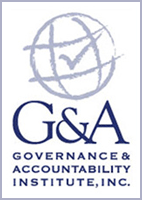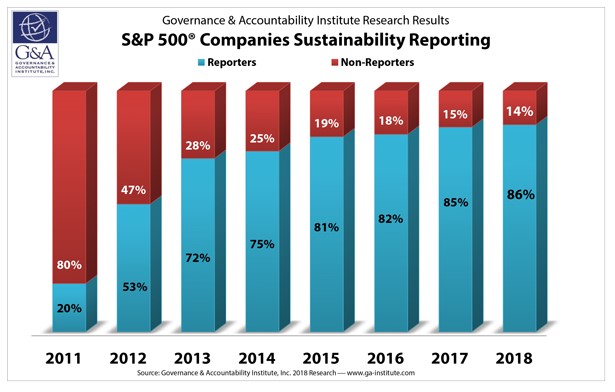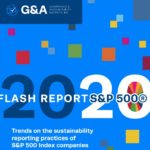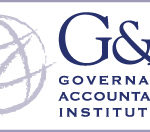
The Governance & Accountability Institute (G&A) research team determined that eighty-six percent (86%) of the companies in the S&P 500 Index® published sustainability or corporate responsibility reports in the year 2018.
This research effort marks G&A Institute’s eighth annual monitoring and analysis of sustainability responsibility reporting of the large-cap companies in the S&P 500 Index® — one of the most widely recognized barometers of the US economy and conditions for public companies in the capital markets. In charting reporting performance in prior years, G&A researchers found that:
· During the year 2011, just under 20% of S&P 500 companies reported on their sustainability, corporate social responsibility, ESG performance and related topics and issues;
· In 2012, 53% of S&P 500 companies were reporting — for the first time a majority of the S&P 500 Index (benchmark);
· By 2013, 72% were reporting — that is 7-out-of-10 of all companies in the popular benchmark;
· In 2014, 75% of the S&P 500 were publishing reports;
· In 2015, 81% of the total companies were reporting;
· In 2016, 82% signaled a steady embrace by large-cap companies of sustainability reporting;
· In 2017, the total rose slightly to 85% of companies reporting on ESG performance;
· And for year 2018, the total inched up to 86% of S&P 500 companies reporting.
Entering 2019, just 14% of the S&P 500 declined to publish sustainability reports. The practice of reporting by almost 500 companies is holding steady with minor increases year after year. The chart below represents the trends of S&P 500 sustainability reporting over the last eight years:
Louis Coppola, EVP & Co-Founder of G&A Institute, who designs and manages the annual analysis, explains: “Many more institutional and retail investors are expecting and even demanding greater corporate ESG disclosure today. This trend has been on a steady trajectory upward and we see the response by S&P 500 companies in our research from 2011 reporting through to 2018.
“The announcements from prominent investor services organizations of acquisitions and mergers in the ESG investor rating space is a signal of the demand from their investor clients. In 2019, the influence of the universe of ESG investor data providers, rankers, and raters has never been greater. In response, an increasing number of corporations are now engaging with these organizations to review their corporate ESG data sets, to learn, update and improve their corporate ESG investor profile, strategy and disclosures. This process of increased engagement is rewarding for all — companies are attracting more long-term patient capital, investors have more decision useful information and the ESG raters and data providers improve the quality and accuracy of their data.
“Our research clearly shows there is a continually shrinking group of reporting holdouts among the S&P 500. Interestingly, when searching for a non-reporters sustainability report, often the first search results are copies of proxy resolutions from investors asking the company to improve ESG disclosure. The pressure is on! There is a lot to lose! Non-reporters are falling further and further behind their competitors every year that they delay.”
Hank Boerner, Chairman & Co-Founder of the Institute, observes: “The original focus of what today is the integrated approach of ESG began with corporate governance — the ‘G’. Over time that focus expanded to include environmental management and a range of social or societal issues. Today, the trend is for the investor to examine the financials, and traditional corporate governance issues as well as the governance of the ‘E’ and ‘S’ in terms of strategy, actions and outcomes. The ‘G’ focus conveys the importance of leading from the top, the board room and C-suite on ESG strategies and oversight.
“We are seeing the intensifying focus on ESG and corporate sustainability among an ever-widening body of fiduciaries, asset owners and the management firms they hire. For example, many more RFPs provided to asset management firms by asset owners are asking for information about the ESG or sustainability policies, processes and outcomes of the asset owners.
“The response of the S&P 500 companies in providing information to both asset owners and asset managers is a broadening and deepening of the information provided in each of the reporting years represented in the chart. The trends we have tracked in S&P 500 reporting is now moving down the market-cap pyramid to companies in the Russell 1000 and even the Russell 2000.
“The S&P 500 companies are the corporate sector top leaders in ESG reporting, striving to explain their ESG / sustainability / responsibility strategies, expanding their governance and oversight of the ESG programs, engaging with their investors and stakeholders, and enhancing their disclosure by publishing sustainability/responsibility/citizenship reports in various formats — and for some companies on a more continuous basis rather than once a year.”




